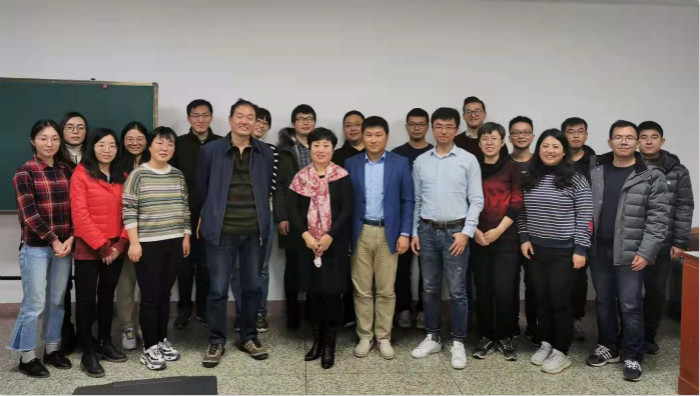Radiobiological Effects Group
Brief Introduction
Based on the Cooling Storage Ring of Heavy Ion Research Facility in Lanzhou(HIRFL-CSR), the Radiobiological Effects Group of the Biomedical Research Center focuses on:
1. new radiation risk assessments and their applications.
2. therapeutic and protective mechanisms of radiation based on immunity and haematopoietic functions
3. chronic biological effects of radiation-induced damage.
The group has established the "Key Laboratory of Space Radiobiology of Gansu Province" and is supported by the fund for innovative research group of new mechanisms and methods of heavy-ion-application in life sciences.
The laboratory is equipped with cutting-edge devices for scientific research. Meanwhile, projects are performed in close cooperation with numerous scientific institutions at home and abroad. At present, the staff includes ten domestic employees, a dozen of graduate students, and two visiting professors from Lanzhou University and Robert Wood Johnson Medical School, University of Medicine and Dentistry of New Jersey, respectively.

Research Team
Research Fields
1. New radiation risk assessments and their applications
People involved in spaceflight, radiotherapy and nuclear-related facilities may be exposed to unexpected ionizing radiation. Since the physics dose-meters have shortcomings regarding the differences among individual radio-sensitivities, using biomarkers naturally existing in living body to assess radiation risk is of great significance for later medical treatment and prognosis. However, the traditional biomarkers such as chromosome aberrations have some limitations. Hence, to find rapid and effective biomarkers to evaluate individual radiation exposure is essential. The Radiobiological Effects Group has conducted the following research:
1) A set of proteins, small RNAs and metabolic molecules from body fluids and tissues, which respond to different doses and different kinds of ionizing radiations,are found out as ideal biomarkers. Models based on multi-biomarkers to assess radiation risk has been established.
2) New biomarkers can be screened out with the assistance of gene and protein chips, and can be used as potential targets for radiation protection and the prognosis.
2. Therapeutic and protective mechanisms of radiation based on immunity and haematopoietic function
1) In recent years, the field of tumour immune response caused by immunotherapy and radiotherapy has been promoted to an unprecedented level. Different from the previous studies only focusing on the killing effect on tumour cells, systematic active tumour immune response is considered to reflect the advantages of radiotherapy better. Therefore, to explore the mechanism of tumour immune response induced by radiotherapy is very meaningful to cancer radiotherapy.
2) Since the manned space flight and moon projects have been put on the agenda, people are paying more and more attentions to radiation protection. It has been Exposure to ionizing radiation can cause immune and haematopoietic dysfunction. Therefore, we focus on the strategies to improve immune and haematopoietic functions, and to explore effective agents that afford ionizing radiation protection.
3. Chronic biological effects of radiation-induced damage
1) Senescence is an important radiation-induced biological phenomenon, which is closely related to a variety of chronic effects. We focus on the classical p53–p21 pathway and senescence associated secretory phenotype (SASP), and try to provide new theoretical perspective for heavy ion radiotherapy.
2) Organelles play important roles in protein synthesis, energy supply and cell homeostasis. Ionizing radiation can induce stress responses in organelles. Investigating the biological effects and mechanisms of endoplasmic reticulum stress, mitochondrial stress and autophagy induced by ionizing radiation could improve radio-sensitivity in cancer radiotherapy.
Achievements
Selected publications in the past five years:
1. Du Yarong, Pan Dong, Jia Rong, Chen Yaxiong, Jia Cong, Wang Jufang and Hu Burong*. The Reduced Oligomerization of MAVS Mediated by ROS Enhances the Cellular Radioresistance[J]. Oxid Med Cell Longev. 2020(1):1-12.
2. Ding Nan, Hua Junrui, He Jinpeng, Lu Dong, Wei Wenjun, Zhang Yanan, Zhou Heng, Zhang Liying, Liu Yongqi, Zhou Guangming and Wang Jufang*. The Role of MiR-5094 as a Proliferation Suppressor during Cellular Radiation Response via Downregulating STAT5b[J]. J Cancer. 2020.11(8):2222-2233.
3. Chen Yaxiong, Pan Dong, Du Yarong, Jia Rong, Li Xiaoman and Hu Burong*. Induction of Cancer Stem-like Cells in A549 Cells after Exposed to Carbon Ions[J]. Int J Radiat Res. 2019.17(1): 25-35.
4. Wenjun Wei, Jufang Wang*, Jinpeng He, Xiaodong Xie*. Serum microRNA as noninvasive indicator for space radiation [J]. Acta Astronautica. 2018.152:101-104.
5. Jinpeng He, Xiu Feng, Jufang Wang*, Wengui Shi, He Li, Sergei Danilchenko, Aleksei Kalinkevich, Mykhailo Zhovner. Icariin prevents bone loss by inhibiting bone resorption and stabilizing bone biological apatite in a hindlimb suspension rodent mode. Acta Pharmacologica Sinica[J]. 2018. 39: 1760-1767.
6. Zhang Yanan, Shi Wengui, Li He, Hua Junrui, Feng Xiu, Wei Wenjun, Wang Jufang, He Jinpeng* and Lei Suwen*. Bone Loss Induced by Simulated Microgravity, Ionizing Radiation and/or Ultradian Rhythms in the Hindlimbs of Rats[J]. Biomed Environ Sci. 2018. 31(2):126-135.
7. Li Xiaoman, Tan Yong, Huang Chunqian, Xu Mengchuan, Li Qian, Pan Dong, Zhao Baoquan and Hu Burong*. MMP Inhibitor Ilomastat Improves Survival of Mice Exposed to γ-Irradiation[J]. Biomed Environ Sci. 2018.31(6):467-472.
8. Wengui Shi, Yuhai Gao, Yuanyuan Wang, Jian Zhou, Zhenlong Wei, Xiaoni Ma, Huiping Ma, Cory J. Xian, Jufang Wang*, Keming Chen*. The flavonol glycoside icariin promotes bone formation in growing rats by activating the cAMP signaling pathway in primary cilia of osteoblasts. Journal of Biological Chemistry[J]. 2017. 292(51): 20883-20896l.
9. He Jinpeng, Feng Xiu, Hua Junrui, Wei Li, Lu Zhiwei, Wei Wenjun, Cai Hui, Wang Bing, Shi Wengui, Ding Nan, Li He, Zhang Yanan and Wang Jufang*. miR-300 regulates cellular radiosensitivity through targeting p53 and apaf1 in human lung cancer cells[J]. Cell Cycle. 2017.16(15):1943-1953.
10. Wei Wenjun, He Jinpeng, Wang Jufang*, Ding Nan, Wang Bing, Lin Sulan, Zhang Xurui, Hua Junrui, Li He and Hu Burong. Serum microRNAs as Early Indicators for Estimation of Exposure Degree in Response to Ionizing Irradiation[J]. Radiation Research. 2017.188(3):342-354.
Photos
Contact
Dr. ZHOU Heng
Tel: +86-931-4969164
Email: hengzhou@impcas.ac.cn
Mailing Address: 509 Nanchang Road, Lanzhou, 730000, China



 甘公网安备 62010202000713号
甘公网安备 62010202000713号


